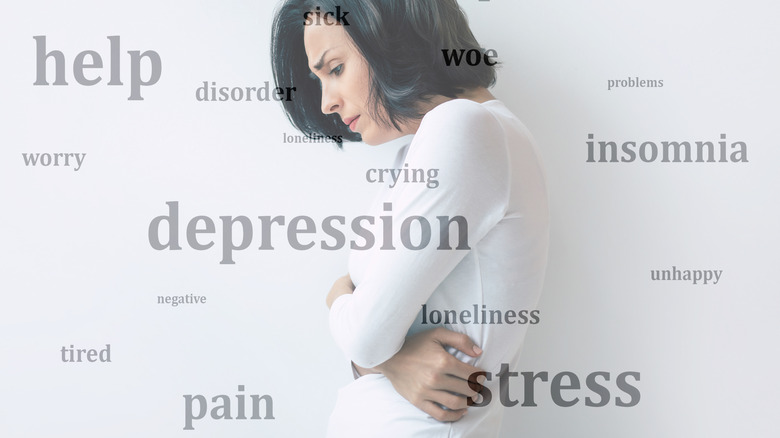Everything You Wanted To Know About Premenstrual Dysphoric Disorder
According to the International Association for Premenstrual Disorders (IAPMD), Premenstrual Dysphoric Disorder (PMDD) is a cyclical, hormone-based mood disorder with symptoms arising during the premenstrual (luteal phase) of the menstrual cycle. It typically subsides within a few days of menstruation.
Despite being connected to the menstrual cycle, PMDD is not a hormonal disorder. PMDD is the brain's extreme adverse reaction to the fluctuating levels of progesterone and estrogen in the body, and it is classified as a depressive disorder in the fourth edition of the Diagnostic and Statistical Manual of Mental Disorders. Women diagnosed with PMDD often experience abrupt mood changes, extreme levels of anger and irritability, anxiety, paranoia, hopelessness, fatigue, and appetite changes (via Healthline). Women living with PMDD experience moderate-to-severe symptoms that can cause significant distress and functional impairment, according to StatPearls.
"It's like comparing occasional headaches to chronic, disabling migraines, PMS may be annoying or uncomfortable for a few days. But PMDD can be like a black cloud that takes all the enjoyment in your life away for half of every month," Laura Murphy, director of education and awareness for the International Association for Premenstrual Disorders, told Psycom.
PMDD affects 3% to 8% of women, equaling a diagnosis rate of one in 20 women. Women with mild PMS may not need medical support, but women with PMDD require intervention to manage anxiety, depression, extreme fatigue, anger, and mood lability (via WebMD).
Symptoms and diagnosis of PMDD
When defining PMDD, identifying the symptoms utilized in diagnosis is critical in understanding the disorder itself. In the fourth edition of the Diagnostic and Statistical Manual of Mental Disorders and the fifth edition of the Diagnostic and Statistical Manual of Mental Disorders, a diagnosis is based on a cyclical pattern of at least five perimenstrual symptoms. Presenting symptoms that qualify a patient to be diagnosed with PMDD are physical, affective, or behavioral symptoms. According to a 2015 article published in Current Psychiatry Reports, a patient must present one symptom of affective lability, such as increased tearfulness and mood swings, irritability or anger leading to interpersonal and internal conflict, tension, depressed moods, or self-deprecating thoughts.
Discussing these symptoms with your healthcare provider is the first step toward a diagnosis. To obtain a diagnosis of PMDD, patients must display at least one symptom of perimenstrual mood lability within a cyclical pattern of two menstrual periods. Tracking psychological and physical symptoms is imperative in obtaining a diagnosis of PMDD, and ruling out the exacerbation of other psychiatric issues. The most reliable form of cycle tracking is the Calendar of Premenstrual Experiences (COPE), which assists doctors in examining the emergence of PMDD symptoms during the premenstrual period. Once a diagnosis is confirmed, your doctor will work with you to find the best treatment option for you.
PMDD treatment options
The first line of treatment for PMDD is selective serotonin reuptake inhibitors (SSRIs). Currently, three SSRIs are approved by the U.S. Food and Drug Administration to treat PMDD — fluoxetine, sertraline, and paroxetine. Other SSRI medications used to treat PMDD are citalopram, escitalopram, and the serotonin and norepinephrine reuptake inhibitor (SNRI), venlafaxine. The efficacy of SSRIs for treating PMDD could be the result of the interaction of these medications with neuroactive steroids (via Current Psychiatry). Your doctor may recommend taking an SSRI or SNRI throughout the month, or strictly during the luteal phase of your cycle to alleviate symptoms.
Hormonal intervention can also be beneficial for women also seeking symptom alleviation and contraception. The approved dosages for the oral contraceptive drospirenone and ethinyl estradiol to treat PMDD are 3mg and 20mcg, respectively. They are taken for 24 days of a 28-day cycle. Patients who experience anxiety, tension, and increased irritability may benefit from taking the benzodiazepine alprazolam during their luteal phase (via the U.S. Pharmacist).
Etiology and risk factors of PMDD
PMDD's cause is unknown, though interconnected pieces of its pathophysiology contribute to its etiology. According to Current Psychiatry, there are five major contributors to the development of PMDD. The contributing factors are genetic susceptibility, sensitivity to neuroactive steroid hormones (NAS), estrogen-serotonin interaction, structural brain differences, pre-existing trauma, and mental health conditions.
Genetic susceptibility indicates a neurobiological component of PMDD, with a 30% to 80% heritability rate. This has been proven through familial and genetic studies. Patients with seasonal affective disorder (SAD) and comorbid PMDD are genetically more susceptible to other comorbid affective disorders.
Exposure to NAS allopregnanolone (ALLO) and the hormone progesterone may impact PMDD. ALLO provides relief in times of stress, but this doesn't occur in women with PMDD. Women with severe PMDD symptoms have lower levels of ALLO, and the increase in ALLO response was lowered in women with PMDD. The connection between the estrogen-serotonin interactions is theorized to contribute to hormone-related disorders, such as PMDD. A 2015 article published in Current Psychiatry Reports suggests that women with PMDD are more sensitive to the effects of estrogens on serotonergic function.
Additionally, women with PMDD have different brain mechanisms, such as increased amygdala responses to negative stimuli. It has been reported that women with PMDD have an intrinsically different network of dynamics within their brains. It is also shown that 80% percent of women with PMDD had experienced early life trauma, with emotional abuse being the most common (via Psychiatry Research).
The psychosocial impact of PMDD
PMDD symptoms impact a patient's ability to function at work and school, and maintain healthy relationships (via Johns Hopkins Medicine). The clinical symptoms of PMDD can wreak havoc on the personal lives of women living with the disorder.
"Many patients who come to see me don't even realize they have PMDD," says Brooke Sprowl, LCSW, clinical director of My LA Therapy. "They think they're 'crazy' or that there is something terribly wrong with their relationships. It's very hard for them to understand what's going on and why."
Depressed mood, irritability, insomnia, and feeling overwhelmed and "crazy'" can lead to the deterioration of interpersonal relationships. Women who are straight and experiencing symptoms present a decrease in shared positive experiences, and increased conflict with their male partners during the last week of their cycle. Comparatively, lesbian couples who both experience menstruation reported increased levels of support and responsiveness to their needs (via PsychCentral).
According to a 2021 article in The International Journal of Environmental and Public Health Research, women with moderate to severe PMDD symptoms reported poorer work–life balance, lower psychological resilience, higher perceived work demands, and less control over work. Despite the added stress of PMDD on work demands, women don't often take time off from work to cope with symptoms because of the social perception of using sick leave for premenstrual symptoms. Additionally, women with male managers were less likely to disclose their PMDD and take time off to manage their symptoms.
Coping with PMDD in Relationships
Within romantic relationships, cognitive behavioral therapy (CBT) for couples can effectively increase coping skills, feelings of support, and positive relationship perceptions. According to a 2017 study published in the PLOS ONE, one-to-one CBT counseling, paired with a couples-based approach can greatly improve a woman's ability to cope with PMDD symptoms. CBT led to reports of decreased premenstrual emotional reactivity, increased partner support, and understanding in study participants.
Additionally, support from family and friends can aid in the management of symptoms. For women with PMDD, creating a strong social network can present challenges. A 2016 study published in the Archives of Women's Mental Health reported that women with PMDD suffer from social impairment, emotion regulation challenges, and limited social connectedness.
To improve these connections, mindfulness-based therapy and emotion regulation therapy may be useful. Providing tools for patients with PMDD can assist them in building a stronger support network for themselves, and lead to more positive emotional outcomes.
Partners often need emotional support, given the added stress PMDD brings to a relationship. Finding support through one-to-one counseling or a support group can be especially helpful. Online support groups are offered through IAPMD and provide safe spaces for people with PMDD and their families.
If you or someone you know needs help with mental health, please contact the Crisis Text Line by texting HOME to 741741, call the National Alliance on Mental Illness helpline at 1-800-950-NAMI (6264), or visit the National Institute of Mental Health website.






